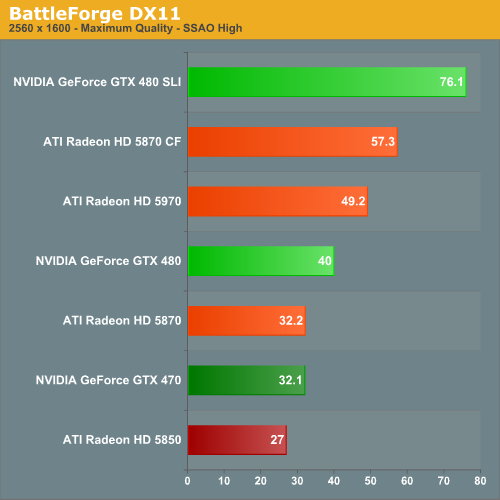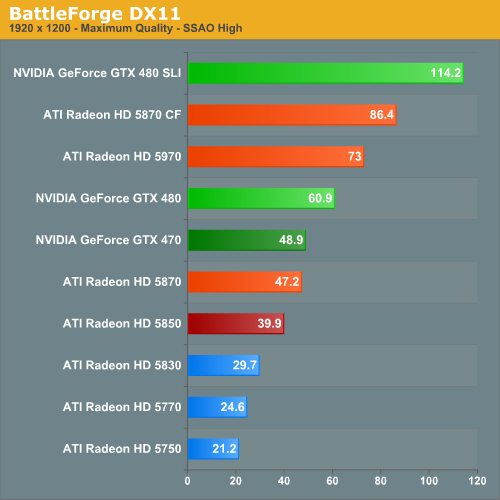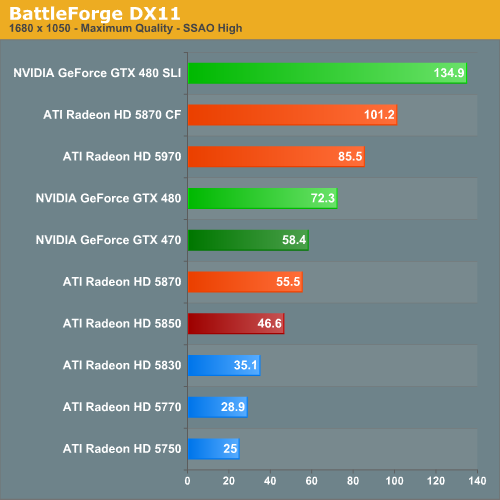NVIDIA’s GeForce GTX 480 and GTX 470: 6 Months Late, Was It Worth the Wait?
by Ryan Smith on March 26, 2010 7:00 PM EST- Posted in
- GPUs
BattleForge: DX11
While BattleForge can be tough under DX10, under DX11 it’s even more brutal. Here we use the DX11 renderer and turn on self shadowing ambient occlusion (SSAO) to its highest setting, which uses a DX11 ComputeShader.



Even with the DX11 ComputeShader, the story remains the same for the GTX 400 series.The GTX 480 enjoys a 20-30% lead, and the GTX 470 takes a smaller 20-25% lead. At this point the GTX 470 is even trading blows with the 5870.










196 Comments
View All Comments
Headfoot - Monday, March 29, 2010 - link
Unless you are an insider all of this "profitability" speculuation is just that, useless speculation.The reason they make both companies chips is more likely due to diversification, if one company does poorly one round then they are not going to go down with them. I'd hate to make ATI chips during the 2900XT era and i'd hate to make nVidia chips during the 5800 FX era
blindbox - Saturday, March 27, 2010 - link
I know this is going to take quite a bit of work, but can't you colour up the main cards and its competition in this review? By main cards, I mean GTX 470, 480 and 5850 and 5870. It's giving me a hard time to make comparison. I'm sure you guys did this before.. I think.It's funny how you guys only coloured the 480.
blindbox - Saturday, March 27, 2010 - link
I know this is going to take quite a bit of work, but can't you colour up the main cards and its competition in this review? By main cards, I mean GTX 470, 480 and 5850 and 5870. It's giving me a hard time to make comparison. I'm sure you guys did this before.. I think.It's funny how you guys only coloured the 480.
iwodo - Saturday, March 27, 2010 - link
If i remember correctly Nvidia makes nearly 30- 40% of their Profits from Telsa and Quadro. However Telsa and Quadro only occupies 10% of their Total GPU volume shipment. Or 20% if we only count desktop GPU.Which means Nvidia is selling those Perfect grade Fermi 512 Shader to the most profitable market. And they are just binning these chips to lower grade GTX 480 and GTX 470. While Fermi did not provide the explosion of HPC sales as we initially expected due to heat and power issues, but judging by pre-order numbers Nvidia still has quite a lot of orders to fulfill.
The Best thing is we get another Die Shrink in late 2010 / early 2011 to 28nm. ( It is actually ready for volume production in 3Q 2010 ). This should bring Lower Power and Heat. Hopefully the next update will get us a much better Memory Controller, with 256Bit controller and may be 6Ghz+ GDDR5 should offer enough bandwidth while getting better yield then 384Bit Controller.
Fermi may not be exciting now, but it will be in the future.
swing848 - Saturday, March 27, 2010 - link
We are not living in the future yet.When the future does arrive I expect there will also be newer, better hardware.
Sunburn74 - Saturday, March 27, 2010 - link
So how do you guys test temps? It's not specifically stated. Are you using a case? An open bench? Using readings from a temp meter? Or system readings from catalyst or nvidia control panel? Please enlighten. It's important because people will eventually have to extrapolate your results to their personal scenarios which involve cases of various designs. 94 degrees measured inside a case is completely different from 94 degrees measured on an open bench.Also, why are people saying all this stuff about switching sides and families? Just buy the best card available in your opinion. I mean it's not like ATI and Nvidia are feeding you guys and clothing your kids and paying your bills. They make gpus, something you plug into a case and forget about if it's working properly. I just don't get it :(
Ryan Smith - Saturday, March 27, 2010 - link
We're using a fully assembled and closed Thermaltake Spedo with a 120mm fan directing behind the video cards feeding them air. Temperatures are usually measured with GPU-Z unless for some reason it can't grab the temps from the driver.hybrid2d4x4 - Saturday, March 27, 2010 - link
Thanks for elaborating on the temps as I was wondering about that myself. One other thing I'd like to know is how the VRM and RAM temps are on these cards. I'm assuming that the reported values are for just the core.The reason I ask is that on my 4870 with aftermarket cooling and the fan set pretty low, my core always stayed well below 65, while the RAM went all the way up to 115 and VRMs up to ~100 (I have obviously increased fan speeds as the RAM temps were way too hot for my liking- they now peak at ~90)
Ryan Smith - Saturday, March 27, 2010 - link
Correct, it's just the core. We don't have VRM temp data for Fermi. I would have to see if the Everest guys know how to read it, once they add support.shiggz - Friday, March 26, 2010 - link
I just am not interested in a card with a TDP over 175W. When I upgraded from 8800gt to GTX 260 It was big jump in heat and noise and definitely at my tolerance limit during the summer months. I found myself under-clocking a card I had just bought.175W max though a 150W is preferred @ 250$ and I am ready to buy if NVIDIA wont make it then I will switch back to ATI.